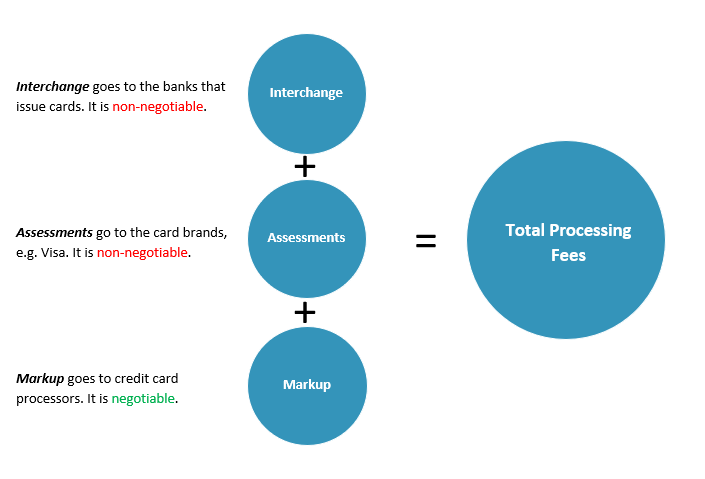What is a good interchange plus rate?
Asking the question “what is a good interchange plus rate?” is like asking the question “how much does a car cost?” Neither question can be answered accurately without first knowing several supporting details.
Interchange plus rates vary widely from one processor to the next. How competitive rates are will depend on your business’s processing profile and how you are gathering quotes.
It’s also important to understand that interchange plus is a form of pricing; it’s not a single rate. The percentage portion of the processing markup (the “rate”) may not be, and often isn’t the most important fee in determining cost-effective credit card processing services.
Competitive Interchange Plus Rates
It’s tough to pinpoint what would be considered a low interchange plus rate without knowing details about a business’s processing profile.
Generally speaking, an established low risk retail business can expect rates in the area of .25%, and an established low risk e-commerce business can expect rates in the area of .35%.
However, changing a few variables can cause rates to vary substantially. For example, a business with a low average transaction amount may be quoted an interchange plus rate of 0% because the majority of expense will come from transaction fees.
Another consideration is how quotes are being gathered. For example, the rates that a business receives will generally be 30-60% lower than the rates the same business would receive from a bank or large processor directly.
The quickest and easiest way to learn what a low interchange plus rate is to ask for help@sbcashregister.com to receive instant quotes from multiple processors. Processors can’t see your contact information, so you don’t have to worry about receiving sales calls or emails.
The Effective Rate Trumps All Others
Interchange plus pricing is only one step toward lower credit card processing fees; it’s by no means a silver bullet to high costs. The most important rate to consider when searching for the best credit card processor is the effective rate.
The effective rate shows the percentage of volume a business pays in credit card processing fees to process a given amount, and it is calculated by dividing gross fees by gross sales. For example, the effective rate for a business that processes $10,000 in sales, and pays $200 in fees is 2% (200 / 10,000 * 100).
Calculating effective rate provides total costs. That makes it the most accurate way to measure the competitiveness of a processing quote.
Calculating the effective rate for each processing quote you receive can be a daunting task, but it’s one that is well worth the effort. Each quote that you receive here at SBCash is fully-disclosed and comes complete with the effective rate already calculated. So, if you would rather avoid the task of calculating the effective rate for several quotes, sign up for free at SBCash, and let our software do the work.
Proof in Numbers
The examples below illustrate why focusing on the interchange plus rate instead of all of the rates and fees in a quote can lead to a costly mistake.
Example #1
For the first example let’s assume the business is a toy store that processes $15,000 a month with an average sale of $19. That means the business will process about 789 transactions.
The first processor offers an interchange plus pricing quote of 0.35% and $0.06 per transaction. The second processor offers a quote of 0.18% and $0.10 per transaction.
The monthly fees for the first processor will be $99.84 (.0035 * 15000 + .06 * 789), and the monthly fees for the second processor will be $105.90 (.0018 * 15000 + .10 * 789).
The second processor’s quote is more expensive even though it offered an interchange plus rate that is only half what the first processor offered. The reason is that this business’s average ticket makes the transaction fee more important than the interchange plus rate.
Example #2
For the second example let’s assume that the business is a newer e-commerce store that processes $5,000 a month with an average sale of $100. That means that the business will process 50 transactions each month.
The first processor offers a quote of interchange plus 0.20% and $0.10 per transaction, with a $25 monthly minimum fee. The second processor offers a quote of interchange plus 0.35% and $0.10 per transaction, with a $5 monthly minimum.
The monthly processing fees for the first processor will be $15.00 (.0020 * 5000 + .10 * 50), but the monthly minimum will add another $10.00 to bring costs up to the minimum charge of $25. So, total actual charges for this processor will be $25.
The monthly processing fees for the second processor will be $22.50 (.0035 * 5000 + .10 * 50). Total charges are greater than the $5 monthly minimum, so no additional charges will apply. That makes the second processor’s offer $2.50 cheaper than the first processor’s offer even though its interchange plus rate is higher.
Getting a good interchange plus rate is important, but the ultimate goal is to find the credit card processing solution with the most value at the lowest cost. If you are not sure exactly how to accomplish this, we would be happy to show you here. Fill out our business profile to see quotes from multiple processors instantly.
Components of Cost
There are three parts to the total credit card processing fee you pay: interchange fees, assessment fees, and processor markup fees.

And if your rate looks like 2.65% plus 15 cents a transaction... Dear god man, ask for help@sbcashregister.com.
